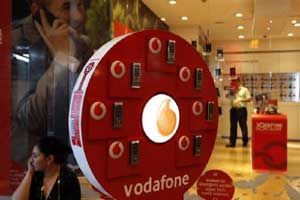Essar will spend $400-500 million on its third generation services electronic equipment before the services are launched in the first quarter of 2011, chief executive Marten Pieters said.
The company will fund this through bank loans and by issuing new shares to its existing shareholders Vodafone Group and Essar Group, he said at the sidelines of a company demonstration of the 3G services it will be launching.
 In May, Vodafone Essar — India’s third largest telecom operator by subscribers — paid 11,618 crore for spectrum, or radio frequency, in nine services areas. The company paid such a high prices because of an artificial scarcity of bandwidth, Mr Pieters said.
In May, Vodafone Essar — India’s third largest telecom operator by subscribers — paid 11,618 crore for spectrum, or radio frequency, in nine services areas. The company paid such a high prices because of an artificial scarcity of bandwidth, Mr Pieters said.
Vodafone’s services will be launched in a phased manner. Beginning from metro areas Delhi and Mumbai, 3G services will be rolled out in all circles including Chennai, Kolkata, Maharashtra, Gujarat , Tamil Nadu, Haryana, Uttar Pradesh (East) and West Bengal, Sanjoy Mukerji, director-business operations, Vodafone Essar, said.
Pieters said Vodafone is in talks with quality and long-term operators — including Bharti Airtel and Idea Cellular — to offer 3G services in areas where it does not have 3G airwaves. The objective of these tie-ups will be to allow customers to seamlessly experience 3G across the country, irrespective of whether it is a Vodafone circle or another operator’s , Sunil Sood, the company’s other director-business operations, said.
Mukerji said 3G services would be competitively priced, adding that every bouquet of services would be priced differently, according to use and location. For example, video calling may be priced higher in a remote location than in cities with adequate mobile access.
In an earlier ET interview, Vodafone Group’s chief executive, Vittorio Colao, had said, “I don’t think that 3G services here will imply all you can use plans — these are being withdrawn from European and US markets. In India, the amount of frequencies are less and it is not compatible with such plans. Data will be segmented and the plans will be tailor-made for different segments of the population.”
Vodafone is likely to be one of the later private player to launch these services. Tata DoCoMo is expected to announce the launch of 3G services from the first week of November. State-run telecoms are already providing 3G services in select circles.
In the highly competitive Indian telecom market, 3G services are being considered the next revenue generator after regular value added services. Consumers may take time to adopt data services that would be priced much higher than existing voice tariffs, which have recently seen radical reduction. “These (3G) services should push up average revenue per user,” said Mukerji without detailing the potential increase. Vodafone expects 10% of 2G network users in India to switch or upgrade to 3G in a year, depending on the proliferation of 3G-enabled handsets, he said.
In India, data users make up less than 10% of the company’s existing consumer base and are expected to increase as 3G usage will be an upgrade from voice calls and not a replacement. Only 2% of Vodafone’s global 3G consumer base uses video calling, and it may find even fewer takers in India.


